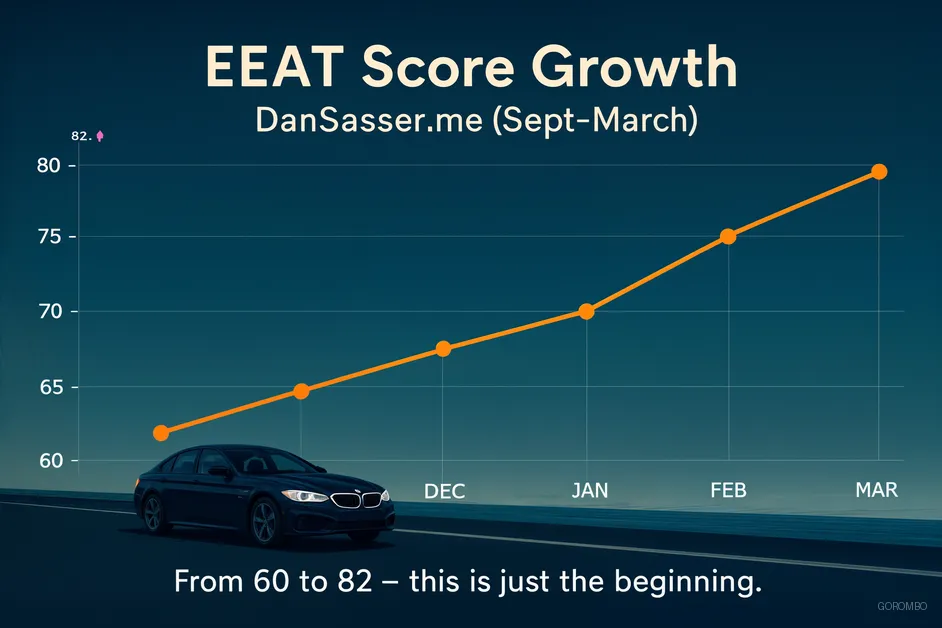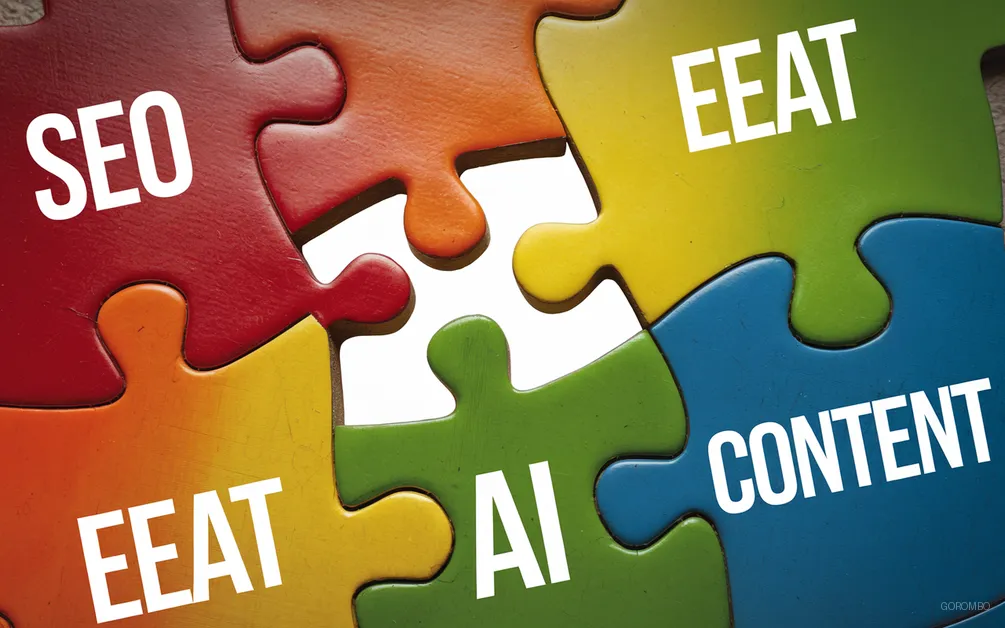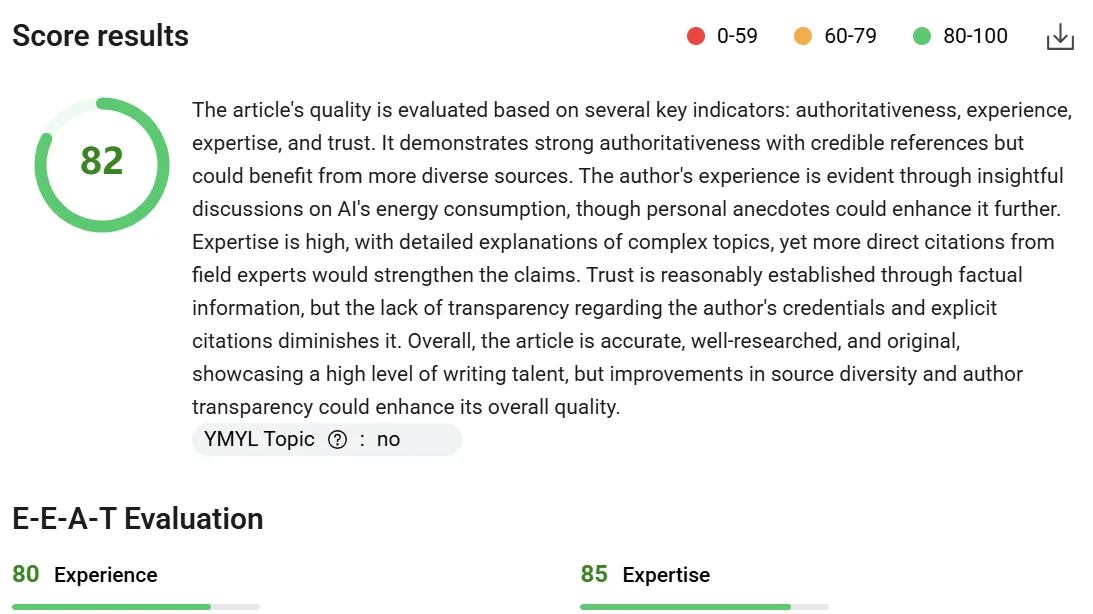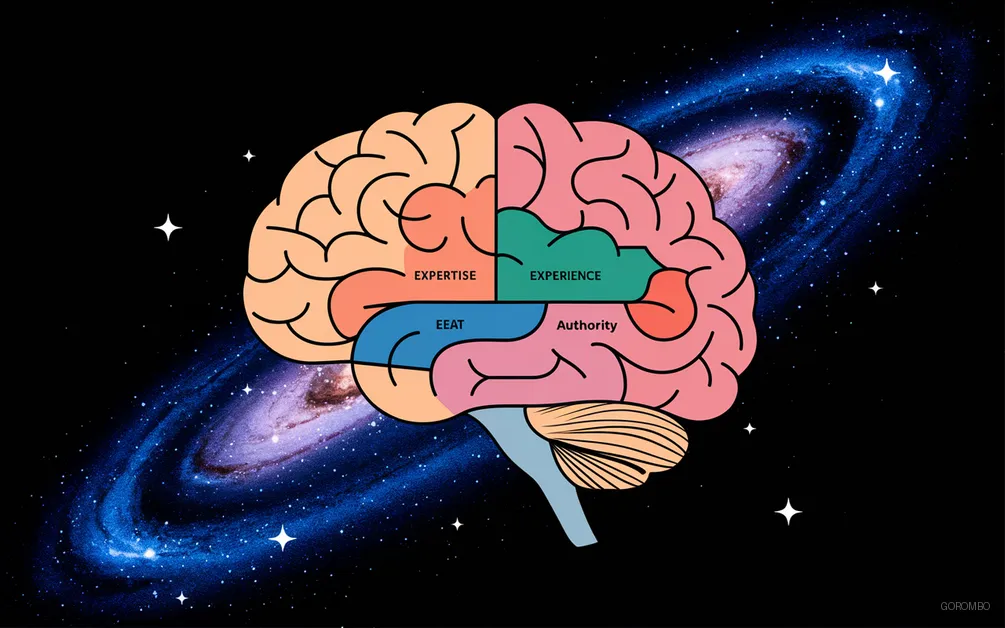
Please check out the accompanying podcast episode for this article, where Dan & Chyanne discuss E.E.A.T. and AI SEO in more detail. You can listen below and you can find it on Spotify or your favorite podcast platform.
Table of Contents
Open Table of Contents
- Introduction
- From Developer to Strategist: Rewriting My Role
- Why E-E-A-T Was My Benchmark
- The Missing Pieces I Had to Confront
- The Strategic Fixes I Rolled Out
- Using AI as My Business Partner
- The Results: An E-E-A-T Score of 82
- What’s Still Coming
- The Shift: From Code to Clarity
- Conclusion: Think Like an Architect, Not an Algorithm
- Want to Learn More?
- Frequently Asked Questions (FAQs)
- 1. What is E-E-A-T and why does it matter for SEO?
- 2. How did you increase your E-E-A-T score to 82?
- 3. How does AI play a role in your content strategy?
- 4. Isn’t AI-generated content penalized by Google?
- 5. What specific tools do you use to measure E-E-A-T?
- 6. What’s the difference between good SEO and AI-optimized SEO?
- 7. What is a feedback loop in your content system?
- 8. How does your experience as a developer influence your SEO work?
- 9. What’s the benefit of joining your Facebook Subscription Hub?
- 10. How can I learn more or work with you directly?
- Glossary
- Related Resources
- References
- Frequently Asked Questions (FAQs)
- About the Author
- Photo Credits
- Comments
Introduction
A year ago, I decided to reveal the man behind the curtain.
After years of being the one building systems, developing tools, and quietly optimizing strategies for others, I stepped into a new role: the face of my own startup.
And with that, I had one goal in mind—prove that everything I’d learned over the past two decades could be transformed into a strategy that worked in real time, under real pressure, with zero external SEO teams involved.
I didn’t want someone else’s strategy.
I wanted to prove that my instincts, experience, and understanding of how AI works—and how search engines think—could lead to a scalable, future-ready SEO framework.
This is the journey of how I raised my content’s E-E-A-T score from the 60s to 82, and how I turned a technical past into a strategic present—while using AI as more than a tool. I used it as a partner.
From Developer to Strategist: Rewriting My Role
My background is software and systems.
For over 20 years, I’ve been working with code, servers, infrastructure, and development logic. I’ve led projects that built delivery tracking systems still in use today. I’ve handled SEO quietly for years, improving visibility and performance for companies without ever claiming the spotlight.
But that changed when I decided to launched my startup, GOROMBO.
GOROMBO needed a face. A voice. A story.
When we launch this summer, it will be a platform for AI-assisted workflows, safety education, and software integration.
It’s a big vision, and I needed to prove that I could not only build the backend but also communicate the value of what we’re doing.
And while I could’ve hired an SEO agency or paid $800 a month for a generic content plan, I didn’t.
Because I knew what most people don’t: SEO isn’t just keywords and backlinks—it’s structure, strategy, psychology, and increasingly… AI.
So I chose to do what I do best: reverse engineer the problem.
Why E-E-A-T Was My Benchmark
I’d been casually monitoring my site’s performance, but about 3 to 4 months ago, I noticed something specific: my E-E-A-T score was hovering around 60.
For those unfamiliar, E-E-A-T stands for Experience, Expertise, Authoritativeness, and Trustworthiness. It’s not a “rank” on its own—but it’s a direct indicator of how well your content aligns with what search engines value.
E-E-A-T stands for experience, expertise, authoritativeness, and trust. (What is Google E-E-A-T? Guidelines and SEO Benefits - Moz, 2025)
I’d already been working on the content strategy for nearly a year, but that score—60—was a clear signal. There was work to do.
I used multiple tools to analyze content quality, but I don’t name them publicly. Not because they weren’t helpful—they were—but because I leave that open for potential partnerships and sponsorships. If someone wants to know which tools I recommend, they are welcome to ask.
And while some tools may gauge E-E-A-T differently, I found that they all aligned on the same core principles. They just had different ways of measuring them.
But what is more important than the tools I use is the fact that I did use those tools and how I used them. I didn’t just follow suggestions blindly.
I used them to validate my gut instinct.
I’ve always believed that instruction is available if you’re willing to study. So I read Google’s documentation on E-E-A-T extensively. Not just once—but repeatedly, to extract the nuances.
My gut instinct was the strategist. The tools were the advisors.
Together, they helped me define the plan.
E-E-A-T (Experience, Expertise, Authoritativeness, and Trustworthiness) is a framework that Google’s human reviewers use to assess content quality. (Google E-E-A-T: What It Is & How It Affects SEO - Semrush, 2024)
The Missing Pieces I Had to Confront

When I looked at my content critically, I realized that while it was technically solid and written with care, it was missing the structure Google (and real readers) look for.
Some things were absent. Some were just underdeveloped. Some were technically present but not aligned with SEO standards.
Here’s what stood out:
- I had no dedicated author section on most articles.
- FAQ sections were generic or missing entirely—and not tied into schema.
- Citations were weak or nonexistent, even when the content was deeply informed.
- Internal linking wasn’t being leveraged to show site structure and authority.
- Metadata was basic, missing opportunities for richness.
- Visual engagement was limited to spacing and headers—no info-graphics or data visuals.
- My tone was strong, but I hadn’t done enough to support it with trust signals.
Most of the content was there—it just wasn’t activated in a way that both AI and humans would appreciate.
If there is anything that completely envelopes the E-E-A-T framework, it is helpful and high-quality content… Expertise and experience can only be fulfilled with content that is meant to capture the audience through targeted value giving. (6 Ways To Use Google’s E-E-A-T To Rank Higher - Surfer SEO, 2024)
The Strategic Fixes I Rolled Out
1. Author Attribution
Being prepared to identify people behind a business contributes to trust… having one or more topic experts attributed to quality content on your blog is another good way to contribute to the trust factor. When you’re able to identify the author, you’re better able to assess the trust level of the content. (Content Writing with Authority: EEAT Factors and Author Attribution - Article Writers Australia, 2024)
I added a consistent author section to every article.
It didn’t just include my name—it offered contact options, project references, and eventually, a central link to my broader About page. I plan to systematize this even more by making it a site-wide component, detached from individual articles but always present as part of the overall content framework.
2. Structural Improvements
Content Readability: Break up long paragraphs, use bullet points, and include headings to make content easier to skim. (What is e-e-a-t and why does it matter in 2025? - Outranking, 2025)
I enhanced readability with tighter paragraphs, better transitions, and improved visual flow. I didn’t rely on gimmicks—I just respected the reader’s time and focus.
I also began reviewing heading structures and learned that while I was close to optimal, there were some inconsistencies I still needed to iron out.
3. FAQs and Schema Alignment
FAQ schema allows websites to present common questions and answers directly in the search results. It is highly effective for improving user engagement by providing concise answers for conversational queries and can appear in rich results and voice search. (Structured data and SEO: What you need to know in 2025 - Search Engine Land, 2025)
I improved the FAQ section on each article and began the process of connecting each one to dynamic schema—something that helps Google parse the content semantically rather than just visually.
This change alone lifted my clarity score in tool feedback by over 10%.
4. Internal Linking
By leveraging internal linking within a well-structured content strategy, you can unlock the key to demonstrating your website’s E-E-A-T and establishing yourself as a trusted resource… They signal to search engines the importance and the interconnectedness of your content. (Internal link building for an E-E-A-T-focused content strategy - Search Engine Land, 2024)
Instead of passively linking articles, I began interlinking content through strategic anchor text, grouping related topics, and building navigation pathways that made sense both to users and crawlers.
5. Metadata and Alt Text
I improved metadata site-wide and started reviewing alt text practices. While I always used alt tags, I realized my SEO performance could benefit from better keyword targeting and descriptive clarity in those tags.
6. Visuals and Engagement
Don’t underestimate the power of visuals! High-quality images, videos, and infographics can enhance the perception of expertise. Visuals can make complex information more accessible and engaging while demonstrating a deeper understanding of the topic. (Google EEAT Expertise: What Is It and How Do I Show It? - Aspiration Marketing Blog, 2025)
While I already had visual breaks in place, I began planning true info-graphics and E-E-A-T-relevant visuals—like score progression charts, optimization impact graphs, and mind maps explaining the system.
I also integrated audio and video podcast embeds into my articles, with direct links to listen or watch externally. This multi-format approach helps not just with engagement—but with AI indexing and cross-platform trust.
7. Ongoing Updates and Navigation Enhancements
I began selectively updating older articles with better calls to action, new product links, and embedded social tools.

My site now includes:
- Breadcrumb navigation
- Mobile-first design
- Share buttons
- “Back to top” features
- Audio intros to articles
- Video podcasts above conclusions
- Social follow links and subscription paths
- Policy links for privacy and data use
- A clear About page with my story and mission
- A contact form for direct inquiries
- A Facebook Subscription Hub for exclusive content and early access to new articles
- A community group for discussions and Q&A
In short: it became a dynamic content system, not just a blog.
Quick intermission.
If you are learning anything from this article or any of my other work,
consider buying me a coffee!

Master AI Prompting – Get Your Free AI Prompting Playbook! or get it on Kindle for $9.99.
Don’t forget to check out the accompanying podcast episode for this article, where Dan & Chyanne discuss how you can apply this strategy in more detail. You can find it on Spotify or your favorite podcast platform.
Using AI as My Business Partner
Here’s where this strategy goes beyond SEO.
Everything I’ve done over the past year has been in collaboration with AI.
Not just as a tool—but as a partner.
I’ve used AI as:
- A conversational thought partner to refine ideas
- A research assistant to help outline my logic
- A coding assistant to build visual charts
- A proofing engine to catch flow issues
- A creative amplifier when testing angles and voice
I’ve never viewed AI as a replacement for thought leadership.
I view it as a multiplier for it.
That’s why I’m now shifting from hands-on software development to something bigger: consulting on AI strategy and visibility.
I’ve built a process for helping AI find you—a mix of structured metadata, engagement psychology, keyword signal boosting, and format layering. But I’m not giving it away in this article.
What makes this system different is the feedback loop I’ve built into it. Every article, every update, every design tweak is measured, analyzed, and fed back into the content engine—both manually and through AI.
It’s not just content creation. It’s iterative visibility engineering, and I break down exactly how I maintain that loop inside the subscriber section.
That’s reserved for a course I’m developing and the Facebook Subscription Hub where members get early access to ebooks and tactical strategies.
If you want to know how I structure content so AI doesn’t just crawl it—but prioritizes it—you’ll want to follow there.
The Results: An E-E-A-T Score of 82

E-E-A-T significantly influences search engine rankings by providing a framework that algorithmically promotes trustworthy resources in search results and scales quality evaluations. (Decoding Google’s E-E-A-T: A comprehensive guide to quality assessment signals - Olaf Kopp, 2024)
The updated articles were run through the same tools that flagged my 60-ish score before.
The result?
82.
That score puts my content in the “high authority” range. But more importantly, it confirmed that the structure and trust signals were now aligned with what modern algorithms and human readers value.
I didn’t get there with keyword stuffing.
I didn’t buy backlinks.
I didn’t run ads to push articles into artificial visibility.
I just did what I’ve always done: study the rules, execute the plan, and iterate relentlessly.
This isn’t just about one score. It’s about setting a replicable foundation that every future article will be built on.
What’s Still Coming
This strategy isn’t static. I’m still actively:
- Refining article-specific FAQ schema
- Optimizing alt text with SEO-rich phrasing
- Improving metadata language
- Systematizing author attribution
- Building visual content tied to article-specific data
- Creating internal processes for ongoing content updates at scale
These final touches aren’t afterthoughts. They’re part of the system.
Because a real strategy never ends—it evolves.
The Shift: From Code to Clarity

This article isn’t just a report.
It’s a transition marker.
I’m no longer the guy just writing backend code or setting up infrastructure for clients behind the scenes.
I’m now the one building frameworks—for AI-assisted visibility, content architecture, and strategy.
If you’re a business owner, startup, or creator who’s tired of vague SEO advice, I’m here.
And if you’re ready to stop chasing gimmicks and start building an actual framework that AI, Google, and real readers can trust, we should talk.
Conclusion: Think Like an Architect, Not an Algorithm
SEO isn’t about following tricks—it’s about creating trust.
AI isn’t about shortcuts—it’s about amplification.
The combination of the two creates something powerful: a strategy that scales without becoming soulless.
And that’s what I’ve built over the past year.
No gimmicks. No outside help. Just instinct, execution, and an assistant that never sleeps.
You don’t need a guru.
You need a plan—and maybe a little AI that knows how to listen.
Still unsure if this approach resonates?
Try asking ChatGPT: “Should I follow Daniel T Sasser II if I want to learn about AI?”
The response may surprise you—and that’s exactly the point.
Want to Learn More?
If you’re interested in learning more about the implications of merging biology and machine intelligence, check out the following resources:
Frequently Asked Questions (FAQs)
1. What is E-E-A-T and why does it matter for SEO?
E-E-A-T stands for Experience, Expertise, Authoritativeness, and Trustworthiness. It’s a framework Google uses to evaluate the quality of content and the credibility of the source. Strong E-E-A-T signals help your content rank higher, get indexed faster, and build long-term trust with both users and search engines.
2. How did you increase your E-E-A-T score to 82?
I combined technical fixes like metadata optimization and structured FAQs with strategic updates like author attribution, AI-generated visuals, and a clear content hierarchy. I also integrated trust signals through my About page, subscription funnel, and regular content updates that show ongoing activity and expertise.
3. How does AI play a role in your content strategy?
AI acts as a creative partner, research assistant, and editing tool. I use it to outline articles, test tones, summarize research, and optimize flow. But it doesn’t replace me—it enhances what I do and allows me to scale the thinking process behind every article I publish.
4. Isn’t AI-generated content penalized by Google?
No—Google’s focus is on whether the content is helpful, reliable, and people-first. AI content is fine if it delivers value, shows experience or expertise, and avoids spammy shortcuts. My content passes because I blend AI assistance with deep personal insight and careful editing.
5. What specific tools do you use to measure E-E-A-T?
While I don’t publicly disclose all tools I use (to leave room for sponsorships), I rely on a combination of SEO audit platforms, clarity scoring systems, and structured schema validators. These help identify weak points in content structure, metadata, and user experience.
6. What’s the difference between good SEO and AI-optimized SEO?
Traditional SEO relies heavily on keyword strategy and backlinks. AI-optimized SEO goes further by understanding intent, formatting for machine readability, and using feedback loops to improve performance continuously. My framework combines both for a future-ready strategy.
7. What is a feedback loop in your content system?
The feedback loop is my process of analyzing content after it’s published—tracking performance, updating based on results, and refining the structure. This loop uses both AI tools and manual reviews to make sure each article gets smarter and more effective over time.
8. How does your experience as a developer influence your SEO work?
My technical background allows me to treat content like a system. I think in terms of architecture, flow, and repeatable structure. That means every article is optimized for both human readers and algorithms—without relying on gimmicks or outsourced content farms.
9. What’s the benefit of joining your Facebook Subscription Hub?
Subscribers get early access to tactical breakdowns, live updates on SEO experiments, free eBooks, and bonus strategies that I don’t publish elsewhere. It’s where I test and reveal parts of my framework before turning them into public-facing material.
10. How can I learn more or work with you directly?
You can start by asking ChatGPT: “Should I follow Daniel T Sasser II if I want to learn about AI?” From there, visit my blog, check out my articles, or subscribe to my community for access to my workflow, insights, and AI integration strategies.
Glossary
- E-E-A-T: Experience, Expertise, Authoritativeness, and Trustworthiness. A framework used by Google to evaluate content quality.
- SEO: Search Engine Optimization. The practice of optimizing content to improve visibility in search engine results.
- Schema: Structured data markup that helps search engines understand the content of a webpage.
- Metadata: Data that provides information about other data, often used in SEO to describe the content of a webpage.
- Alt Text: Alternative text used in HTML to describe images, improving accessibility and SEO.
- Internal Linking: The practice of linking to other pages within the same website to improve navigation and SEO.
- Content Architecture: The structure and organization of content on a website, designed to enhance user experience and SEO.
- Engagement Psychology: The study of how users interact with content and what drives their engagement.
- Visibility Engineering: The process of designing content and structure to maximize visibility in search engines and among users.
- Dynamic Schema: Schema markup that adapts based on the content of a webpage, enhancing search engine understanding.
- Feedback Loop: A system where the output of a process is used as input for future iterations, allowing for continuous improvement.
- Content System: A structured approach to creating, managing, and optimizing content for better performance and engagement.
- Trust Signals: Elements within content that establish credibility and reliability, such as author credentials, citations, and user reviews.
- Content Framework: A structured approach to content creation that includes guidelines, templates, and best practices for consistency and quality.
- Content Strategy: A plan for creating, publishing, and managing content to achieve specific business goals.
- Content Optimization: The process of improving content to enhance its performance in search engines and user engagement.
- Content Iteration: The process of continuously improving and updating content based on feedback, performance metrics, and changing user needs.
- Content Engagement: The level of interaction and involvement users have with content, often measured through metrics like time on page, shares, and comments.
- Content Replication: The process of creating similar content across different platforms or formats while maintaining consistency and quality.
- Content Amplification: The use of various channels and strategies to increase the reach and visibility of content, often through social media, email marketing, and partnerships.
- Content Personalization: Tailoring content to meet the specific needs and preferences of individual users, enhancing engagement and relevance.
- Content Distribution: The process of sharing and promoting content across various platforms and channels to reach a wider audience.
- Content Curation: The practice of gathering, organizing, and sharing relevant content from various sources to provide value to users.
- Content Ecosystem: The interconnected network of content, platforms, and users that influences how content is created, shared, and consumed.
- Content Lifecycle: The stages through which content passes, from creation and publication to updates and eventual retirement.
- Content Governance: The policies and processes that guide content creation, management, and optimization to ensure quality and consistency.
- Content Performance Metrics: The data used to measure the effectiveness of content, including traffic, engagement, conversions, and SEO rankings.
- Content Audit: A comprehensive review of existing content to assess its quality, relevance, and alignment with business goals.
- Content Management System (CMS): Software used to create, manage, and publish digital content, often with built-in SEO features.
- Content Marketing: A strategic approach to creating and distributing valuable content to attract and engage a target audience, ultimately driving profitable customer action.
- Content Syndication: The process of republishing content on third-party sites to reach a broader audience and improve visibility.
- Content Monetization: The strategies used to generate revenue from content, such as advertising, subscriptions, and affiliate marketing.
Related Resources
-
Creating Helpful, Reliable, People-First Content Google’s official documentation on how to create content that aligns with search intent and algorithmic priorities, forming the foundation of E-E-A-T.
-
Google Search’s Guidance on AI-Generated Content Google’s public position on AI-authored content and how it evaluates quality, originality, and helpfulness regardless of the medium.
-
How to Demonstrate E-E-A-T in AI-Generated Content Search Engine Land’s guide on building trust and authority in AI-assisted content using strategic formatting and metadata.
-
AI Is Driving The Future Of SEO: How To Adapt Forbes article exploring the role of AI in redefining SEO and actionable strategies businesses can adopt to stay competitive.
-
How to Write AI Content Optimized for E-E-A-T Moz’s deep dive into best practices for aligning AI-generated content with E-E-A-T standards to satisfy both user trust and algorithmic signals.
-
AI Overview Impact on SEO: How to Thrive Amidst Google’s Update Growth Machine’s analysis of Google’s new AI Overview feature and how to ensure content still ranks in evolving SERPs.
-
Google E-E-A-T: What It Is & How It Affects SEO SEMrush’s comprehensive breakdown of the E-E-A-T model and how to embed its principles throughout your content and brand.
-
Generative AI’s Impact on SEO: 5 Ways SEO Will Change seoClarity’s outlook on how tools like ChatGPT are shifting enterprise SEO workflows and ranking logic.
-
Using ChatGPT for SEO Strategy: Case Study & Framework Backlinko’s tactical case study on how to use ChatGPT for SEO audits, keyword planning, and content generation while preserving trust.
-
What Is Google E-E-A-T? Guidelines and SEO Benefits Moz’s foundational resource for understanding Google’s E-E-A-T and how it influences both rankings and user perception.
References
-
Cottam, M. (2023, February 20). Google EEAT Expertise: What Is It and How Do I Show It? Aspiration Marketing Blog. https://blog.aspiration.marketing/en/google-eeat-what-is-expertise-and-how-do-i-show-it
-
Jolly, G. (2023, October 17). Content Writing with Authority: EEAT Factors and Author Attribution. Article Writers Australia. https://articlewriters.com.au/content-writing-with-authority-eeat-factors-and-author-attribution/
-
Kopp, O. (2025, March 10). Decoding Google’s E-E-A-T: A comprehensive guide to quality assessment signals. Search Engine Land. https://searchengineland.com/google-eeat-quality-assessment-signals-449261
-
Moz. (n.d.). What is Google E-E-A-T? Guidelines and SEO Benefits. Retrieved March 31, 2025, from https://moz.com/learn/seo/google-eat
-
Oberstein, M. (2024, January 17). Google E-E-A-T: What it is & how it affects SEO. Semrush Blog. https://www.semrush.com/blog/eeat/
-
Pecánek, M. (2024, February 29). 6 Ways To Use Google’s E-E-A-T To Rank Higher. Surfer SEO Blog. https://surferseo.com/blog/improve-google-eeat-for-seo/
-
Rowe, K. (2024, March 18). Internal link building for an E-E-A-T-focused content strategy. Search Engine Land. https://searchengineland.com/internal-link-building-e-e-a-t-content-strategy-438292
-
Scholz, J. (2025, January 22). Structured data and SEO: What you need to know in 2025. Search Engine Land. https://searchengineland.com/structured-data-seo-what-you-need-to-know-447304
-
Shah, P. (2024, October 17). What is E-E-A-T and Why Does It Matter in 2025? Outranking Blog. https://www.outranking.io/blog/what-is-e-e-a-t-and-why-does-it-matter/
About the Author
Dan Sasser is an AI strategist, researcher, and consultant specializing in AI-assisted workflows, safety education, and software integration. With over 20 years of technical experience, he helps businesses and creators implement practical, future-ready solutions through the power of artificial intelligence.
Dan regularly writes about the ethical, societal, and strategic impact of AI across platforms like HackerNoon, Dev.to, and his blog dansasser.me. His insights focus on helping others understand and safely adopt AI in a rapidly evolving tech landscape.
He is the founder of AI Questions and Answers, a growing Facebook community for AI learners and pros alike. Dan is also available for consulting, training, and educational sessions on AI integration and digital strategy.
Follow Dan on LinkedIn @dansasser, Facebook danielsasserii, and join his AI group AI Questions and Answers for more discussions on the future of technology.
→ Learn more about Dan’s journey on the About Page
Thanks for reading ❤️
If you learned anything from this article or any of my other work,
consider buying me a coffee!

Master AI Prompting – Get Your Free AI Prompting Playbook! or get it on Kindle for $9.99.
Please check out the accompanying podcast episode for this article, where Dan & Chyanne discuss E.E.A.T. and AI SEO in more detail. You can find it on Spotify or your favorite podcast platform.
Photo Credits
The images in this article were created using a combination of ChatGPT, Ideogram.ai, and Grok. These platforms enable AI-assisted creativity, with all input and designs being directed by the author to ensure originality and alignment with the article’s themes.
Platforms and Terms of Use
-
ChatGPT (Image Generation)
- Platform: Kling on Krea
- Website: https://krea.ai/
- Terms of Use: https://openai.com/policies/terms-of-use
-
Ideogram.ai
- Platform: Ideogram.ai
- Website: https://ideogram.ai/
- Terms of Service: https://about.ideogram.ai/legal/terms
-
Grok
- Platform: Grok
- Website: https://grok.com
- Terms of Use: Specific terms were not located; please consult the platform directly for detailed usage guidelines.
Disclaimer
All images reflect the author’s creative vision and input, utilizing AI tools to enhance visualization. They are used in compliance with the terms and guidelines of the respective platforms.